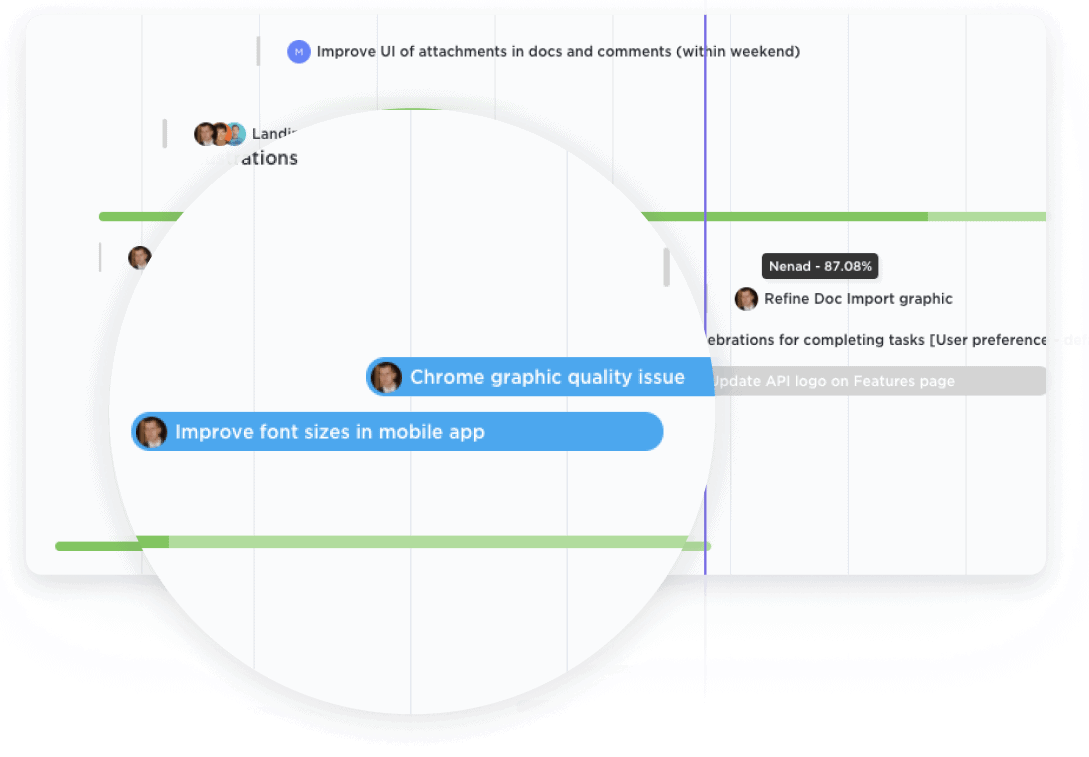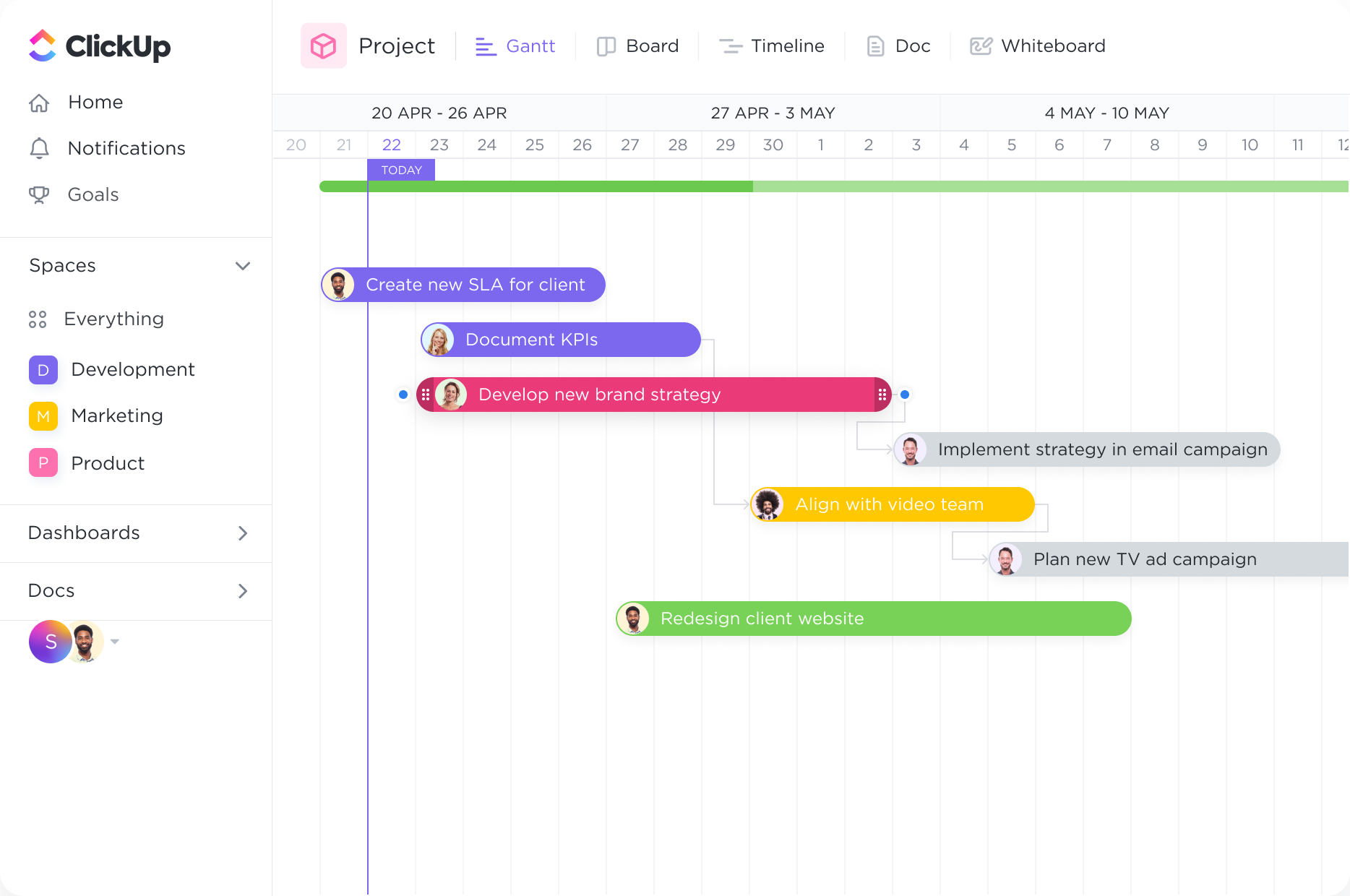Manage all of your projects in one place.
Get a bird's-eye view of all Spaces, Projects, Lists, and tasks in one Gantt chart. With clear coloring options, you can easily see what work is happening and where.

Streamline hospital management with ClickUp's powerful Gantt Chart software. Plan, track, and manage critical tasks with ease, using a user-friendly interface that allows you to visualize project timelines, assign resources, and monitor progress. From scheduling surgeries to coordinating patient care, ClickUp's Gantt Chart software empowers hospital administrators to stay organized and deliver efficient healthcare services. Take control of your hospital management processes today and see the difference ClickUp's Gantt Chart software can make.
Free forever.
No credit card.

Trusted by the world’s leading businesses
Get a bird's-eye view of all Spaces, Projects, Lists, and tasks in one Gantt chart. With clear coloring options, you can easily see what work is happening and where.

Organize how you see your tasks with quick sorting. Create cascading views with a single click to easily see what important tasks are coming next.
Hospital construction and renovation projects involve various phases and stakeholders, making it essential to have a clear timeline and task allocation. Gantt charts can help in visualizing and managing these projects, from the initial planning stages to the final completion. They enable hospital administrators to track the progress of different construction activities, allocate resources effectively, and ensure that the project stays on schedule.
In a hospital setting, managing staff schedules and shifts can be complex, especially when dealing with multiple departments and different roles. Gantt charts provide a visual representation of staff availability, allowing administrators to allocate shifts efficiently and ensure adequate coverage. By incorporating factors like employee preferences, workload distribution, and compliance with labor regulations, Gantt charts help optimize staff scheduling and minimize conflicts.
Hospitals rely on a wide range of equipment and resources to provide quality patient care. Gantt charts can be used to track the availability, maintenance, and allocation of critical resources such as medical equipment, operating rooms, and specialized facilities. By visualizing the usage and availability of these resources, hospital managers can optimize their utilization, reduce downtime, and ensure smooth operations.
Efficient patient admission and discharge processes are crucial for hospitals to provide timely care and manage bed availability. Gantt charts can help in planning and coordinating these processes by visualizing patient flow, bed occupancy, and resource allocation. Hospital administrators can track the progress of each patient's journey, identify bottlenecks, and ensure a smooth transition between different stages of care.
Hospitals continuously strive to improve the quality of care they provide. Gantt charts can be used to plan and monitor quality improvement initiatives, such as implementing new protocols, conducting audits, or introducing patient safety measures. By outlining the tasks, deadlines, and responsible parties, Gantt charts enable hospital administrators to track the progress of these initiatives and ensure that they are completed within the desired timeframe.
Hospitals invest in training and professional development programs to enhance the skills and knowledge of their staff. Gantt charts can be used to plan and schedule these programs, including training sessions, workshops, and certification courses. By visualizing the timeline, resource allocation, and progress of each program, Gantt charts help hospital administrators ensure that staff members receive the necessary training and development opportunities.
Gantt Chart software can help in managing hospital projects and tasks efficiently by providing a visual representation of the project timeline, tasks, and dependencies. It allows for better resource allocation, tracking of project progress, and identification of potential scheduling conflicts. This enables effective coordination, communication, and decision-making among team members, leading to improved efficiency and successful completion of hospital projects.
Yes, Gantt chart software can be integrated with existing hospital management systems, providing a visual representation of project timelines, tasks, and dependencies. This integration enables effective coordination and scheduling of hospital activities, enhances resource allocation, and improves communication among healthcare professionals, resulting in more efficient and streamlined hospital management processes.
Gantt chart software can help hospital management by providing a visual representation of tasks, timelines, and dependencies. This allows for better planning and coordination of medical procedures, staff scheduling, and resource allocation. It also enables the tracking of progress, identifying bottlenecks, and ensuring timely completion of projects. Additionally, Gantt charts enhance communication among healthcare teams, improve patient care coordination, and facilitate data-driven decision-making.